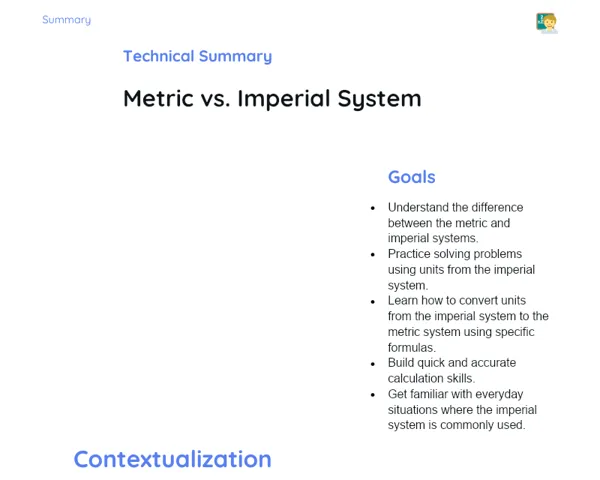Socioemotional Summary Conclusion
Goals
1. 🔍 Investigate the properties of quadrilaterals.
2. 📏 Calculate unknown angles using the sum of the internal angles of the quadrilateral.
3. 🔢 Differentiate between the main types of quadrilaterals, such as squares and rectangles.
Contextualization
🏠 Fun fact: Did you know quadrilaterals are everywhere? From the windows of our homes to the screens we use, and even in sports fields, these geometric shapes play a vital role in design and architecture! Let's explore how knowing their properties can help us tackle everyday challenges and make better decisions! 🚪📐
Exercising Your Knowledge
Definition and Properties of Quadrilaterals
Quadrilaterals are polygons with four sides. There are various types of quadrilaterals, each having unique features that set them apart. Grasping these properties not only simplifies the process of solving mathematics problems but also helps us admire the geometry around us and utilize this knowledge in practical situations.
-
Quadrilaterals are geometric figures with four sides.
-
The main types include squares, rectangles, rhombuses, parallelograms, and trapezoids.
-
Each type has specific properties, like equal sides and right angles.
-
The sum of the internal angles of any quadrilateral is always 360 degrees.
Squares and Rectangles
Squares and rectangles are particular types of quadrilaterals with distinct properties. A square has four equal sides and four right angles, while a rectangle possesses four right angles with opposite sides being equal. Recognising these differences empowers us to identify and apply these shapes in daily life.
-
Square: Four equal sides and four right angles.
-
Rectangle: Four right angles and opposite sides equal.
-
Both shapes are commonly found in everyday items, like tables and sports courts.
-
Understanding the differences aids in practical tasks, such as home decoration and architecture.
Calculation of Internal Angles
Calculating internal angles is a fundamental skill in geometry. For any quadrilateral, the sum of internal angles is always 360 degrees. Understanding this concept enables us to solve mathematical issues and make informed decisions based on reliable data.
-
The sum of internal angles in a quadrilateral is consistently 360 degrees.
-
Dividing a quadrilateral into two triangles can help in visualising this sum.
-
A practical method is to subtract the sum of known angles from 360 degrees to find an unknown angle.
-
This skill is beneficial in everyday contexts, such as design and engineering.
Key Terms
-
Quadrilateral: A polygon with four sides.
-
Internal Angles: The angles formed inside a geometric shape.
-
Properties: Characteristics that define and distinguish types of quadrilaterals.
-
Sum of Internal Angles: Total of the internal angles of a geometric figure, which is always 360 degrees for quadrilaterals.
For Reflection
-
👥 How did collaborating with peers to create quadrilaterals influence your emotions? What feelings came up and how did you manage them?
-
🔄 When you encounter challenges in calculating angles or drawing quadrilaterals, what emotional strategies do you employ to persevere?
-
🏗️ In what ways can you apply your knowledge about quadrilaterals in real life? Consider daily scenarios where this skill is useful and reflect on the significance of learning geometry.
Important Conclusions
-
📐 Quadrilaterals are polygons with four sides, each possessing unique properties.
-
🔢 The sum of internal angles in any quadrilateral is always 360 degrees.
-
🏠 Squares have four equal sides and right angles, while rectangles feature four right angles and opposite sides that are equal.
-
📏 Calculating internal angles is a valuable skill applicable in numerous daily situations.
Impacts on Society
Quadrilaterals are a significant part of our everyday life, influencing architecture and design. From constructing buildings to designing furniture and household items, understanding these properties allows us to create stable and visually appealing structures. In architecture, for example, employing rectangles and squares correctly ensures the stability and functionality of buildings.
Moreover, studying quadrilaterals helps us develop important skills like problem-solving and critical thinking. These skills are vital for academic success and for making informed choices in our personal and professional lives. By comprehending the geometry around us, we better appreciate our world and are empowered to confront challenges more effectively.
Dealing with Emotions
To help manage your emotions while exploring quadrilaterals, try the RULER method. First, recognize your feelings when you face a math problem, whether it's frustration or satisfaction. Next, understand the reasons behind these emotions, like difficulty in solving the issue or experiencing success. Label these emotions accurately and express them wisely, whether through discussions with a classmate or jotting down your thoughts. Finally, regulate these emotions using techniques like deep breathing or taking breaks to remain calm and focused. Consistently practising this method will enhance your resilience and effectiveness in your studies.
Study Tips
-
📚 Review the Concepts: Regularly revisit your notes and materials related to quadrilaterals to strengthen your understanding.
-
🎨 Use Visual Aids: Sketch the different types of quadrilaterals and label their properties to aid in memorization.
-
🤝 Study in Groups: Collaborate with your peers to solve problems and discuss concepts, fostering cooperative learning and reinforcing knowledge.



